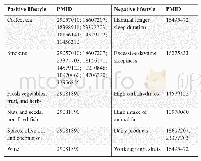《Table 3Positive and negative outliers recovered from regression analyses of Daodi species, and of C
 提示:宽带有限、当前游客访问压缩模式
提示:宽带有限、当前游客访问压缩模式
本系列图表出处文件名:随高清版一同展现
《Medicinal plants of Chinese Pharmacopoeia and Daodi:Insights from phylogeny and biogeography》
“Re”columns:Regression analysis,Numbers show ranking of family in each ethnomedicinal flora,starting from one with largest residual value as recovered from regression analyses.Numbers followed by“*”indicate that family was recovered as a positive out
The map of the Daodi regions was shown in Fig.1,and the climatic and ecological variation found in the regions was exhibited in Table 1.Daodi are unevenly distributed across China,for example Nan is much smaller than Xi but it is the source region of many Daodi plants.Six Daodi regions,Bei,Huai,Nan,Zhe,Gui,and Chuan,are limited to only one vegetation type.Guan and Xi,the largest regions span four and five vegetation types respectively.Considering the 34 plant traits,21 are significantly unevenly distributed amongst the ten different Daodi regions(Table 2).However,there are only nine traits which show significantly different distributions between all Daodi plants in total and the remainder of the Chinese Pharmacopoeia.There are more significantly hot and warm plants with pericardium and bladder as target organ amongst Daodi.There are fewer whole plants and flowers,but fruits and seeds and roots are found more often in Daodi.The full distribution of plant traits was shown in Table 2,indicating comparisons between the Chinese Pharmacopoeia and Daodi,and between the different regions of Daodi.
| 图表编号 | XD007999300 严禁用于非法目的 |
|---|---|
| 绘制时间 | 2018.07.18 |
| 作者 | Di Leia、Jie Wu、Christine Leon、Lin-fang Huang、Julie A.Hawkins |
| 绘制单位 | School of Biological Sciences,University of Reading、Institute of Chinese Materia Medica,China Academy of Chinese Medical Sciences、Royal Botanic Gardens,Kew,Richmond、Institute of Medicinal Plant Development,Peking Union Medical College & Chinese Academy of |
| 更多格式 | 高清、无水印(增值服务) |



![Table 2:Electro negativity values and difference of elements[27]](http://bookimg.mtoou.info/tubiao/gif/ZZAF201902002_08600.gif)

